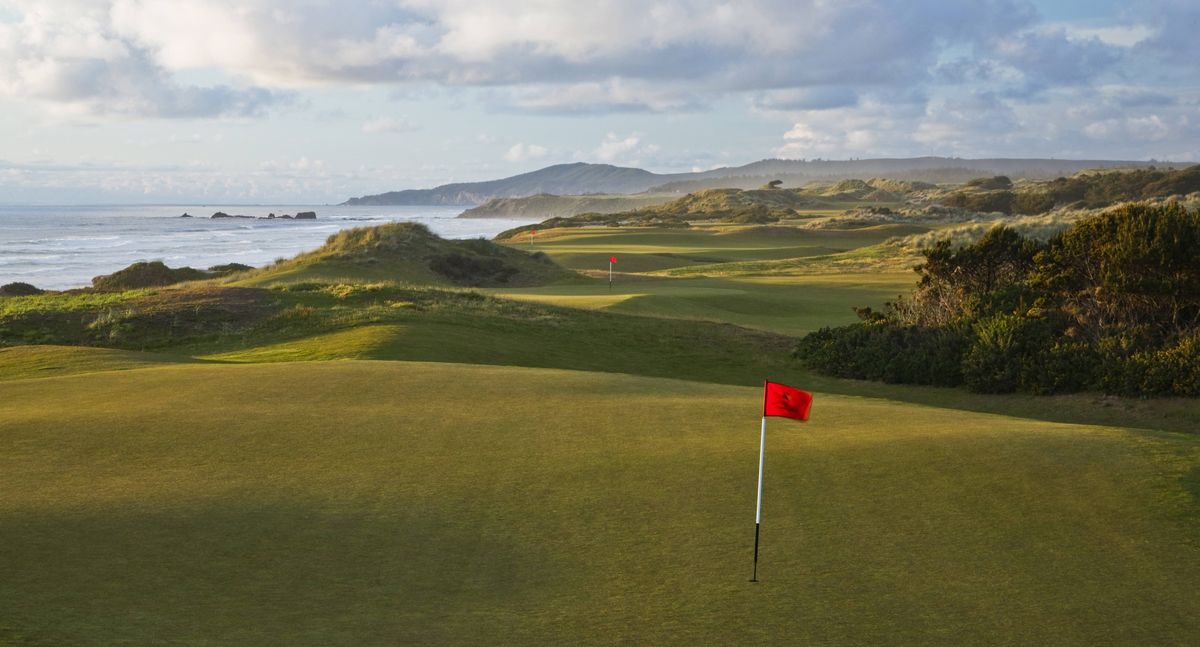Bandon Dunes original course turns 15, but hardly showing its age

The last round on our two-day, 72-hole odyssey came at Bandon Dunes, the first course to open at the resort.
In my mind, we saved the best for last.
You’ll get plenty of arguments from your buddies on their preferences, but Bandon Dunes would be my pick. It’s a fairly easy walk, the layout is clever and the views are often beyond description.
Bandon Dunes strikes a perfect balance: challenging and enjoyable. The credit goes to Scotland’s David McLay Kidd, who made a wildly successful debut as a designer at Bandon Dunes. The course turned 15 this spring.
“The thing that stands out is at the other three courses if you make a mistake you can bring a big number into play,” director of golf Jeff Simonds said. “Bandon Dunes is kind of sneaky good. It’s very straight forward and there’s probably not a huge blow-up hole out there. But you can get on the bogey train.”
It can play as the longest of Bandon’s four courses in terms of yardage (7,212). Whatever tee box you choose, judging the impact of howling winds will be a priority. No. 1 was a prime example. Facing a headwind, I belted a driver into a fairway bunker that I thought was unreachable. Hello double bogey.
The uphill, 189-yard par-3 second stung me, too. I hit just short of the green and my ball tumbled back down a slope some 50 yards. The par-5 third yielded two short birdie putts – one of which dropped – but the gorse along the left edge of the fairway swallowed up a hooked second shot.
The dogleg-right, 362-yard fourth starts innocently. We mis-clubbed and our drives bounded through the fairway into high grass. The second shot is straight out of a postcard, into a green surrounded by the Pacific.
“I still get excited for that second shot,” Simonds said. “That green looks like it’s floating in the ocean. You might hit a hybrid off the tee and you’re not expecting much. And then it’s, ‘Whoa.’ ”
The fifth and sixth holes stay along the coastline, a rarity in that both run in the same direction. The sixth is 161 yards, but gusting winds stretched it to roughly 185.
No. 7 turns away from the ocean and offers maybe the most generous landing zone on the premises. The test starts on the second shot. Keep your drive to the left for the best angle into the elevated green. From the right, the hill becomes a factor and keeping your ball on the proper tier of the green is a chore.
We didn’t have many eagle putts in two days, but one came on the downwind, 558-yard ninth.
The 384-yard 11th was into the teeth of the wind. It’s one of the toughest par-4s on the course.
One of the toughest par 3s is the 199-yard 12th, in part because of a front-left pot bunker. If 12 wasn’t the toughest, 15 just might be. It’s 163 yards, but we were pulling 4-irons into a brisk wind. Do not mess with the deep bunker off the right side of the green.
The closing stretch is memorable, beginning with the scenic 16th, a 301-yard par-4 that is drivable and also double- and triple-bogeyable. There are two fairways separated by a mound of high beach grass. The upper fairway is probably the preferred route and affords a shorter second shot but not an ideal angle into the green.
The par-4 17th offers several fairway bunkers and a huge ravine on the right. There are enough golf balls down there to equip a foursome for a decade. An uphill approach to a long, wavy green is no bargain.
The par-5 18th takes you back toward the clubhouse. Nobody in our group was close to reaching in two. It’s possible your view will be blocked on the second shot so use the clubhouse as an aiming point. The green happily accepted the last of my many three-putts.
On one of our shuttle rides we ran into a gentleman from Pittsburgh. He said it was his second trip to Bandon. He played in heavy rain and high winds on his first venture to Oregon.
“We try to remind people if the wind is blowing 40 mph it’s not a par 72,” Simonds said. “Suddenly a 400-yard par-4 is now a 600-yarder. Most people if they play on a desert course it’s tough to remember the shots you hit. You have that day here where it’s blowing and you hit a 4-iron on a 120-yard shot, you remember.
“That gentleman from Pittsburgh had horrible weather (last year), but he came back.”